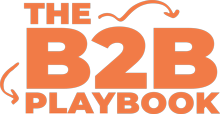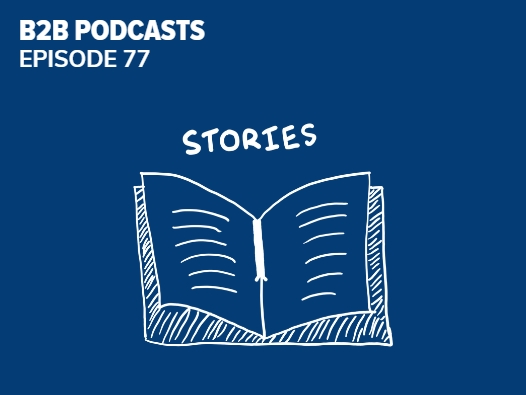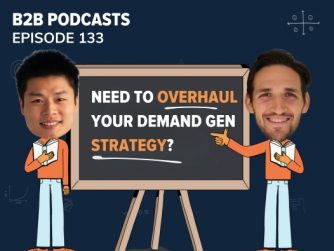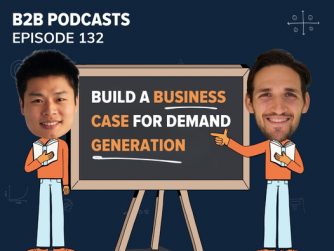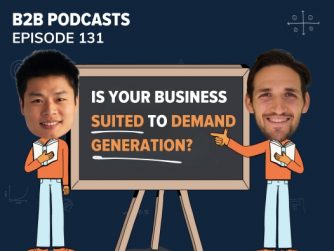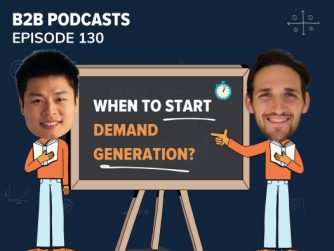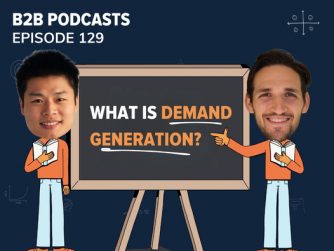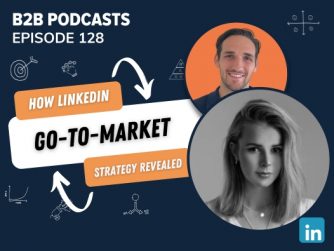Scale can be a problem in itself..
As your business grows, the mission gets fuzzy and the brand gets harder to explain.
That can happen internally and externally.
It makes it harder for your brand to stand out, and certainly makes your job as a B2B marketer harder!
If it’s hard for your team to remember the tagline, how will your customers remember what it is that you do and your potential customers to understand your value?
That’s where revisiting your storybrand comes in.
This week, we not only revisit what that’s all about, but also give you practical examples and tips on how you can use it at the Be Better stage of your B2B marketing journey.
Watch The Episode
Links Mentioned:
A Stanford study by Gordon Bower and Michal Clark in 1969
Sign up to our newsletter for the latest news and summary of the best content.
If you enjoy the podcast. Would you kindly consider leaving a short review? It takes only a minute and helps make a big difference in getting those amazing guests! We also love getting your insights by reading the reviews!
Transcript
George Coudounaris: Welcome back to the B2 B Playbook, Kevin. [00:01:00] Today, listeners, we are talking about the formula that marketers can use to get their customers to listen to and remember them. It’s an episode that’s very heavily inspired by Donald Miller’s building a story brand.
Kevin, where are we in season four of the b2b Playbook?
Kevin Chen: George season four we’re in, be better the fourth be of our framework. We’re really getting closer towards the end here as we get to the content and We’ll have some great interviews coming up for you listeners. But right now we’re still going through the things that you can do To better your B2B marketing workflow, and that’s what be better is all about. Now that we have the fundamentals in place in our first three Bs. And as George said, today we’re covering how to build a story brand.
George Coudounaris: So listeners and uh, we’re not just giving you the Spark Notes version of building a Story brand, right? Kevin and I have actually applied this um, our own business. We’ve applied it to our clients, and we’re gonna talk you through very real examples.
So I just wanna start off by saying, Kev, that, and you know [00:02:00] this, but creating a brand that can communicate very simply to your customers. I mean, That’s something that I guess you and I would think is part of the fundamentals of a brand, right? Like That is that’s really, really core in identifying yourself as a brand. But the reason that we even included in the Fourth Bees of our Five Bees framework, the Be better stage is because it’s normally only at this stage that a business actually has a lot more clarity on who its best
Kevin Chen: Yeah. So I think it’s really important, George, as you said, to go through this exercise and be better. There’s a bunch of other reasons why it’s important, which we’ll touch on in a second. But definitely want to reemphasize that as you get to the point where there’s a lot of growth happening, the business is getting bigger, there’s a lot more people in the business. And to really be on the same page across the board and how that brand is communicated.
George Coudounaris: I think B2B in particular, Kev, they can really learn from Um, A lot of people might read something like this and dismiss it as b2c, but you know, there’s still humans on the other side of this. And [00:03:00] storytelling, the principles that this book are based you know, are very much centered around humans. And is still a human on the other side. and marketing and branding attempts fail because quite frankly, their marketing is just far too complicated particularly in the B2B context, right?
Like normally we try and get so and we’re So insular when we’re thinking about our own products and our own services that we often don’t really think about the customer who is a human on the other Now studies show that the more simple and predictable the communication is the easier it is for the brain to digest. If we make it too hard to understand for the customer how we can help them and why they should care, then they’re just gonna ignore us and keep scrolling past us. Kev.
Kevin Chen: I think because of that, George, it applies even more in the B2B context.
A B2C context. it’s, a product, often it’s a very simple service, and it’s easy to communicate something that’s more tangible like that. Whereas in b2, There’s so many [00:04:00] benefits in your offering. It might come as a package. There’s different services involved and how you use the same product can vary from product to product, service to service and customer to customer. So there’s a lot of benefits and pain points you want to touch on in a B2B space. But to do it simply and to do it effectively, as George said in that context, make sure that your customer actually understands why you exist and the value that you bring to them. That is actually harder in the B2B context, so it’s actually even more important to continually refine. What is that story around your brand?
George Coudounaris: And just to get that additional buy-in care from our listeners. So they really tune into this episode. Look, really the best way to get those dream customers to comprehend and remember this information that you want them to about your brand is to form a story Now. Story formulas, put everything in order so the brain just doesn’t have to work to understand as much [00:05:00] what’s going on.
And Kev, you and I seem to pull up a few more studies now than have, uh, in the past. I don’t, I’m not so sure why, but a Stanford study we’ve got here by Gordon Barron, Michael Clark in 1969, Kev found long-term retention of a list of words was six to seven times higher when put into a story format. Now, a good story is also gonna help you move leads through your pipeline. So bring it right back to the context of b2b because if you put information in a story, it’s gonna help educate how you can solve their problems, and it’s gonna tell them why they should act now.
Kevin Chen: Now, we’ve covered a lot of this listeners already in very early episodes in The podcast because it does also form part of the fundamentals that we talked about. So we talked about it in Be Ready and Getting Your Story brand ready was part of that.
But here, as George said, you now have a better understanding of your customers. You might have some customers now that you’re further along in your journey that you can study and [00:06:00] really learn from, and then you can refine that story or you can use the same story, but just as a reminder to focus back in on that message around the brand, go back to market with that same story.
It helps you retain your existing customers better remind them of that story, helps you drive new customers who might need a slightly different story or a refined story, if you will.
And it also helps your internal team reengage in the brand, reengage with the mission that you are all after, if that is indeed an issue.
#This Episode…
George Coudounaris: So today listeners, we’re gonna share that formula for stories that you can use to get your customers to listen to and remember you.
First up in the episode, we’re gonna start with the common mistakes that brands typically make when talking about their products and services. And then we’re gonna share our six step formula that you are gonna be able to take away and use for your own business.
And then finally, kev, you and I are gonna talk through examples as [00:07:00] to how our listeners and viewers can use this storytelling in their marketing.
#Common Mistakes:
George Coudounaris: Alright. First up, a common mistake that brands make when talking about their products and services. The huge one that we see Kev really often is they just make their customers burn far too many calories in an effort to understand their You know, We’re all on a health kick. We’re all trying to lose weight. But this is not the time to get your customers to try and do that, kevin.
Why is the human brain burning calories when trying to um, your product offering or if The human brain has a survival mechanism that’s really designed to tune out the useless information around us in order to conserve calories. , this is because, you know, and we’re going a bit caveman here, Kev, but this is because really once our essential needs as humans are met, things for survival, like food and water.
Our brains are designed to really just save our energy. So we tend to tune out totally non-essential information. A really good analogy that Miller [00:08:00] uses in his book, actually, Kev, is imagine you were trying to explain what your product or your service does to a customer, but as soon as you start talking about it, the customer has to jump on a treadmill and start jogging.
How long do you think they’re actually gonna stop to listen to you for
Kevin Chen: Uh, Long mate, and I could tell you, I need to burn some calories here. As I’m in Porter currently eating a few too many Petista bananas, Portuguese tarts, and maybe I just need to find a few convoluted B2B brands to help me burn a few more calories.
But as you said, customers won’t really be jumping on that treadmill and jogging while they’re really listening to you. So you really need to listeners reduce the number of calories that your customers need to burn, and that’s a very common mistake, as George said.
There’s a miad of examples out there of B2B brands that do this, but generally you think of any big organization that offer a lot of service You know, your big consulting businesses big banks, insurance companies, [00:09:00] the message around what they offer is pretty convoluted. And you can see, with the really good ones that you remember, you probably have a pretty clear idea of that one tagline of what they’re about, what they’re talking about. It might not even be that related to what they actually do on a day-to-day basis, but they do try and build a story around that.
And the reason why you retain it is probably because that tagline forms part of a story that’s easy to understand and easy for you to recall.
#The Story Format – 5-6 Elements
George Coudounaris: And when it comes to that story format, Those stories, those big brands use and those blockbuster films use, they really communicate five very, very clear things that your dream customers, your audience really care about.
And they are, who is the hero? What does that hero want? Who does the hero have to defeat in order to get what they want? And what tragic thing will happen if the hero doesn’t win? And then finally, what wonderful thing will happen if they do?
So that’s the story formula that our brains care, they’re [00:10:00] built to understand and care about. And as I said, every big blockbuster in the movies follows this format.
Ke came to the point um, I was returning from Europe on a flight You know, Listeners we’re in Australia, it’s like a 30 hour round trip back I like to tune back into the bl blockbusters. I watched a lot of the back to back to back, and then I like the Batman series back to back to back. it kind of started to become boring, Kevin, because once you formula formula and you work out the formula, you know what’s gonna happen. And I didn’t start to experience those same heart palpitations in those battle scenes when you think, oh my God, are they gonna be okay? What’s gonna happen next? Because every great story, every great mainstream story follows this same.
Kevin Chen: yeah, we might be putting a few spoilers out there, ruining a few movies for people, but it definitely is the case and you can steal that same format, follow the hero journey and do that journey as well with your products and services to create that same [00:11:00] sort of effect of a story following through with your.
George Coudounaris: All right, Kev. Well, We’ve spoken about blockbusters. Let’s get into a specific example. We said we were gonna get into examples and there’s no better one. I think that’s perhaps more relatable than Star Wars.
Hopefully most of our have seen the seen the Star Wars movies. But if you have, you’re probably gonna remember the story because it centers around the main character, Luke Sky. And Luke, who’s our main character, he encounters the problem of the Empire and the death star. He then meets a guide in Yoda and he learns the Jedi Arts, which provides the skills that he needs to defeat the evil empire. Luke is then pushed into action by the Empire’s actions to crush the And the perils are clear, Kevin, if he fails, the galaxy falls under the Empire’s rule, but the rewards are also very clear. If he succeeds, they obtain freedom for the galaxy.
So [00:12:00] for anyone tuning into our YouTube, we can see here very clearly this format that Star Wars follows.
Now, this story is very easily remembered, right? We don’t need to remember every detail, every piece of dialogue, or even the sequences of events and scenes, but you do remember the overall.
Kevin Chen: Yeah, it is very easy to remember.
So if we apply the s StoryBrand elements to this, we can see the same five key elements coming through. So there’s a character who wants something. So that’s Luke. They encounter a problem before they can get it. so you have the Desta, the Empire Darth vader, and then at the peak of their despair, A guide steps in into their lives to give them a plan on how to go about getting what they want. So then you have Yoda, OB one Kenobi even, and then there’s a call to action. Things happen. The empire’s, crushing their resistance. And that action helps them avoid failure, in this case, losing to the empire and in success. So blowing up the death [00:13:00] star and, getting the resistance in power.
So I think if we’re applying that story brand, Into our own context, into the B2B marketing context. There are a few key points to focus on when you’re building your story brand. So the first is the hero in the story is not your company. So that’s another common mistake that we see a lot of businesses focus in on talking about the story of their brand.
It really should be about the customer themselves. You should focus on the customer as the hero of the story, because that’s what matters. That’s what’s gonna get the emotional response. That’s what’s gonna get the logical response from them retaining the story and eventually working with your brand.
You, in fact, are the guide in this story. So you are the Yoda in the journey and you’re trying to give them the way to the end that they want.
#2 key points in applying the 5 elements of a story to B2B
George Coudounaris 2: is so cool. Who doesn’t want. to be little Yoda? Kevin?
And they’re Definitely the two biggest points that, I think that their listeners Are to take away from this. And the two biggest mistakes people make is they often try and make their [00:14:00] business the hero of the story. I don’t know why companies always do this, everyone who’s so obsessed with their own origin story, but it actually needs to be about the customer, cuz quite frankly, They don’t care about you. They really don’t like they might eventually, but first you have to show that you care about them and understand them.
And second of all, absolutely you are not the hero, but you are the guide. And you know what? The guide is a great role to play. Kev, I think you in particular love playing the role of the guide.
Kevin Chen: I do George. Maybe it’s an ego thing. Maybe. In fact I like hearing my voice a little more than I let on . But I do think, there’s value in being a guide, and it’s what we do here on the podcast.
But I think importantly for companies, If you take on that mantle of the guide, if people trust you, and it’s an often used term in sales, I think when they talk about a trusted advisor. If you become a trusted advisor, the things that you say will have a lot more impact. It’ll be a lot easier for you to. Get [00:15:00] impact from actions that you take. So it’s actually a great role for companies to have when they want to influence sales journeys, when they want to influence a certain customer group, into doing something.
And it’s a win-win. It’s not necessarily manipulating people to a bad end. You’re providing a service or product that will make their lives easier, and hopefully it’s a win-win, both for you as the company and for the person that you’re guiding in your customer.
George Coudounaris 2: I love looking at it like that, Kevin, that businesses. Are the guide, and we’re just trying to guide our customers, and it really aligns with our framework, right? Everyone always talks about your typical funnel of awareness, consideration, purchase, and the idea that they’re trying to shove these people down the funnel.
As we got deeper into b2b, we realize, Kevin, that these people they’ve gotta choose their own path. Everyone has their own different purchasing path. It’s incredibly complex and involves a lot of people, so the best that you can hope for is to be the guide and provide them all those tools. To help them [00:16:00] find their own way.
But you’ve gotta think about yourself as that guide, because if you’re just trying to shove people down a funnel, they’re not gonna respond to you. They’re not gonna listen.
Kevin Chen: That’s a very good point, George. When a customer hits a particular pain point, hits a particular place that they need some help on. If you are the person or your business. The place that they turn to get that help. Then that says a lot about your pulling power, about your place in the industry, and therefore the potential for you to have a win out of that customer and for the customer to have a win out of the help they get from you.
#Real World Example
George Coudounaris 2: right, Kevin, listeners, let’s go into a real world application of this story format into a B2B context.
So I’m gonna give you an example of a client that I work with, Kevin and this particular client. They’re a company that helps track e s G metrics, environmental, social, governances metrics for really, really large businesses.
Something in particular that they help these large companies comply with is an act in [00:17:00] Australia called the Modern Slavery Act. It’s a great act that gets companies to look at their supply chains to see how much slavery is going on in there and to help them try and improve on that year on year.
Unfortunately, we all have so much slavery in our supply chains. it’s a reality of not, whether they have it or not, but how much. And so this act really puts the onus on the businesses to investigate as much as. now their software, this company software, they help to look into this a lot faster than manually doing this yourself.
So if we’re gonna try and break down their company into the story brand format, Kev, I imagine it would go something like this.
The character in this case is normally, again, it’s not the company itself, Kev, it’s the head of procurement. So we’ve actually identified really a key. Um, Within these companies that they work with, their clients, and it tends to be the head of procurement, who is the one who is obliged to help their companies [00:18:00] submit what is called a modern slavery statement.
So the modern slavery statement shows that you’re complying with the Modern Slavery Act. So they have to do it because that becomes their job, but they also want to be seen as leading ESG initiatives at their. That’s really important for brand reputation. It’s, I’m sure good to advance your own personal career to Kev if you’re getting this stuff underway.
So that’s the character. Now, what problem are they dealing with? Well, It’s pretty shocking, but there’s still over 40 million slaves still worldwide, Kev. So complying with the Modern Slavery Act, it actually requires you to survey all of your suppliers, and that’s a huge task. So I, if you’re a closed manufacturer, you’ve gotta go to every person who’s involved in manufacturing your clothes, and you’ve gotta survey them to make sure. The chances of slavery being in your supply chain are as low as possible. That’s a huge task. And companies don’t have divisions of people dedicated to [00:19:00] this. Normally, their data is all over the place. Supplies are difficult to get onto and they can be difficult to deal with as well. And meanwhile, Kev, there’s a yearly deadline that our hero, that head of procurement has to meet each and every. And forces them to get their modern slavery statements submitted on time. So that’s a pretty serious problem.
The guide or solution, Kev, the third step? The company that I work with, they give their clients the tools that they need to survey the suppliers, so they help you formulate your modern slavery statement much faster.
There’s of course, a lot of benefits beyond that, but I think that’s really the key one there. the call to action. You know what is really calling us to action? Why do we need to act now? We’ve got that yearly compulsory compliance state that companies have to submit their modern slavery statements By.
This company’s quite fortunate, Kevin, that there is a very clear call to action, a reason why [00:20:00] they need to act. Now, that’s not always as clear in other businesses, but that trigger is very essential in. Then finally care if the perils of failure. What happens if they don’t do this? If a company doesn’t do this, the company actually gets named and shamed as a company that didn’t submit a statement, and that’s really bad for their brand image.
The rewards of success. It’s the opposite, right? It’s great for their brand image. The head of procurement tackles a huge task. The ceo, the company looks great. Everyone gets pats on the. There’s more visibility over the supply chain and that business can make better e s G decisions and is hopefully doing its best to remove slaves from its supply chain and improve that situation.
So Kev, that is an example as to how you can apply it in a very real world B2B context.
Kevin Chen: Well Ness, I think again just as a reminder, the key things to focus on here when you’re applying the story brand or reapplying it to your businesses [00:21:00] brand, is to keep your customer in mind when telling your story. They’re the hero of the story. Don’t make it your company. It’s all about your customer, because that’s, Really gonna have the impact,
and you need to really define what that customer wants and position your brand as that trusted and reliable guide to getting whatever it is that they want.
So again, make sure that your company is taking on that mantle of being a guide.
George Coudounaris 2: Okay. Careful that it sounds like a pretty simple five step process. I think we might have said it six steps in the beginning, Kev. I guess it depends on whether you. include the perils of failure. The rewards of success is separate steps. I would argue they’re together. But anyway, five or six steps.
Hopefully our listeners have started to formulate some ideas in their own head as to how they can apply this to their own business. I really encourage you guys, when you’re done with this, just sit down and go through with a pen and paper each of those key points and try and write out from the point of view of your custom. That hero’s [00:22:00] journey, that five or six step journey.
And once that’s done, Kev Wellers might be asking themselves, great, I have this story. What the hell do I do with this?
#Practical Applications Of The Brand Story
Kevin Chen: Well Listen, there’s a few practical things you can do with your story from here.
The first is update your messaging quite simply on your, website, on your um, materials that you support your sales process with. Even your paid ads, you can update the messaging to better reflect that brand story that you’ve now tweaked or have refocused it on.
So on the website, you can edit. How early do you communicate that new message? Is there anything that’s outta line with that you can tweak? Make it obvious who your company services is for and what they want to get out of it by engaging with your brand and also call out how you, as the guide can help you get them there.
The, another great one to do is to create a one liner. This is something like an elevator pitch that you. Repeat at any time to someone who asks what [00:23:00] you or your brand does. You can add it to your website to email signatures to business cards if you’re still using those in this modern day of digital. And importantly, it’s also something that you can use to easily communicate and get everyone aligned with. Internally as well. It’s all about how to make your customer’s lives easier, and understanding what your business is about, but also how to make your internal customers your team, understand That same point as
George Coudounaris 2: That one liner can be really hard to nail down, but it is really important because as you said, Kev it’s the one thing. That can stick in that, in, in the mind of your customer, of your other team members and I guess invites them to discover the rest of your story.
I just looked one up, Kev as an example in the B2B context and HubSpots very simply was grow better with HubSpot.
And I think that’s pretty good, right? Cuz it invites you to wonder how can I do that? But it tells you what it does. By using HubSpot [00:24:00] I can grow better. It’s probably touches on any pain points that people already have. They’re experiencing growing pains. HubSpot covers that journey from that free tier.
When you have no customers all the way to that enterprise tier, and you have pains as you go, up that chain. And with HubSpot, you can grow better. And I think that’s a really nice, simple one liner for them to have.
Kevin Chen: Yeah, that’s a great example, George.
I think it’s a also a great example for our listeners to get an idea of what that one liner looks like. It doesn’t have to be very specific. And hopefully not too general either. But at the same time, it strikes that balance. and it invites people in to find out more, to find out exactly how that will happen and to speculate about how to grow better.
And as George just did that, it invited us to speculate on how that could happen on our understanding of it. So that’s doing exactly what the tagline is doing.
Other things you can do with your story is you can deliver your story out [00:25:00] in an automated drip email campaign. So maybe you touch. One key element in each email in a series to really extend the time you have to tell the story to your potential customers and existing customers to reengage with them on that story front and to build a stronger brand in the process and build a stronger relationship of trust as well.
It can also help. as a process as a stepping stone for you to start collecting off the back of that and tell real customer stories of that same transformation story that you are trying to communicate. A jumping off point for you to speak to your dream customers, to speak to your existing customers who you want to improve, to get their story to see where following that journey, you can improve their story. As they interact with your brand, and then to retell some of the best ones to help sell your brand
George Coudounaris 2: It’s like Kev, when you get to the end of, a decent to average movie, and then the final scene, it goes black, and [00:26:00] then over the top it says based on a true story. I think that’s why really. Collecting those real customer stories because all of a sudden you’re like, oh my God, this is something that actually happened to someone. and for some reason it’s just so much more powerful cuz you’re like, this not only could happen, which makes it an interesting story and has those key five elements, but it did happen to someone. I dunno about you, but I think that always makes a very average movie a pretty good.
Kevin Chen: I agree. And I think maybe we’ll start seeing ads out there that end with, based on a true story, , that might that might increase
George Coudounaris 2: Oh, I reckon we’re gonna start testing some ads care for the B2B incubator soon. Maybe that’s something we can test out.
Kevin Chen: Yeah, definitely.
All right, listeners, key takeaways from this episode. The key to clearly communicating with your customers is to create a story around your brand. Placing your customer at the center of that story and you acting as the guide.
There’s five key elements to a story like that. A first must have a character who then runs into a [00:27:00] problem. Who meets a guide to overcome that problem? There’s a call to action for that particular hero of the story, and then there’s clearly perils of failure and rewards of success.
Take the time to craft your brand story and then update your messaging and use it as a stepping stone to growing your brand and trust.
George Coudounaris 2: Beautiful. Very good, Kevin. Thank you. Listeners, you can find links to everything that we’ve discussed in the show notes. As we said, we have our YouTube channel up and running, so please go and check it out. You can see Kevin, my big stupid heads there and some interesting visuals that we’ve put together to hopefully make this an even more powerful learning and fun experience for you.
Um, As per usual, we’re so grateful that each week, more and more marketers are tuning in every Monday to the B2B playbook. And if we can ask one thing, it would be to please leave us a short review on whatever platform it is that you listen on, or pass it on to someone who you think would get value from the show
Or now, Kev, leave us a comment on our YouTube channel. That’s a huge help to [00:28:00] us and we’d
Really appreciate it. I know we asked for one, we said we’d ask for one thing, we’d now have asked for three, but whatever, hopefully you’re getting value from this. Take care. See you next week listeners. Thank you.
Kevin Chen: Thanks listeners. Thanks, George. See you next week.
A quick note before you go listeners, you can find more great content and get in touch with us@theb2bplaybook.com. Be sure to subscribe to this podcast and our newsletter while you’re there to get the latest news, tips and resources from our playbook. We’ll be back the same day and same time with another episode next week.
Thanks for tuning me in to the B2B Playbook. Remember, successful B2B marketing starts with the buyer.
